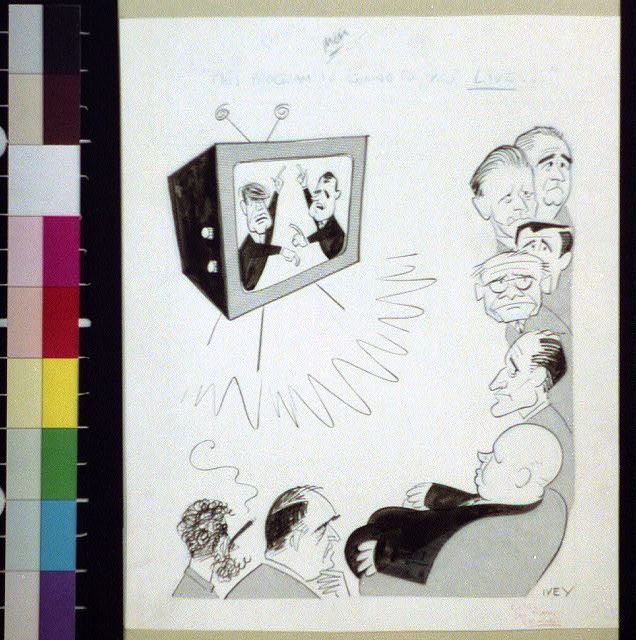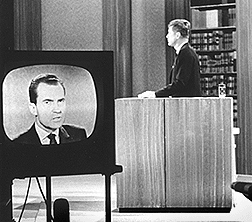




As with most history websites, my debate site incorporates elements of other genres. For example, it includes a small archive of primary sources. However,it obviously fits most comfortably into the “teaching and learning” category. 1 If the main criterion for assigning a genre is the intended audience, then the television debate site is a teaching site. There are three history sites that seem particularly useful in terms of providing elements that might be incorporated into my debate site. The first two include substantial teaching sections and the third is almost entirely a teaching site. A fourth site provides a model for the type of small topical site that my debate site will be.
American Memory
American Memory ( http://memory.loc.gov) is an example of an archival site that makes a major effort to address the needs of teachers and students. This site, which has over seven million items in its archive, includes an extensive “Learning Page” that was designed to assist elementary and high school teachers in using this vast archive in their classrooms. It is a remarkably comprehensive source that includes not only information on the process of historical research—explaining for example, the “time and place rule,” and the “bias rule,”—but also detailed lesson plans on a wide variety of historical topics. The plans can be accessed by links listed either chronologically or thematically. If, for example, a high school teacher wants to concentrate on the topic of segregation there is a unit called “From Jim Crow to Linda Brown.” Everything a teacher could possibly need is available, including a list of learning objectives, activities, printed resources, evaluation tools, etc. A typical activity has students simulating the 1953 “National Afro-American Council” meeting to “consider the status of the race at mid-century.” The students are divided into committees to do web research on topics such as the Ku Klux Klan, the Tuskegee Airmen, or W.E.B. DuBois. Committee spokesmen then report the results of their work back to whole “Council” for discussion.
Though part of an archival website “The Learning Page” is an exemplary model of a teaching site. Everything a teacher needs to present a learning unit is available. Indeed, the television debate site might incorporate links to “The Learning Page” which includes a great deal of generic information and activities on historical research that are appropriate for high school students and undergraduates. For example, the so-called “mind walk” activity asks each student to re-trace what they have done during the past 24 hours and think about what evidence they have left behind (credit card receipts, trash, diary entries, etc.) that a historian could use in writing an account of the day. The how-to research information on “The Learning Page” could be used for any research teaching unit, and learning activities similar to those on the “Page” could be devised for the debate site. A classroom simulation similar to the Jim Crow activity might be used to introduce the debate site unit. This might require students to research the candidates’ stands on the issues of a specific election year and then present them in a TV debate format with a panel of students asking the questions. The students’ performances could then be compared to those of the actual candidates.
DoHistory
Harvard University’s Film Study Center’s DoHistory (http://dohistory.org) is an example of a historical site that provides a collection of primary material related to a specific topic. The site focuses on Laurel Thatcher Ulrich’s book and movie A Midwife’s Tale that relate the story of midwife and healer Martha Ballard who kept an increasingly detailed diary during the years of the late 18th and early 19th centuries. The site also includes, not only Martha’s diary in original and transcribed form, but also the entire book and video clips from the movie as well as additional primary sources such as an 18th century book on the “Practice of Midwifery.” This site is a good example of a site that uses primary source material as “clues” to solve historical “mysteries.” For historians and students alike, the site states that, “the challenge is to try to make sense of the diary, the documents, and the questions they raise.” Students are invited to be “detectives” in using these sources to interpret Martha’s life and the times in which she lived. The site’s “History Toolkit” provides a wealth of information for beginning historians, including everything from how to compile an oral history to “how to read a graveyard.”
DoHistory has been called “the most fully realized and sophisticated history website available on the Web today.” 2 Aside from its one-topic approach, it provides several elements that might be used in my television debate site. Certainly the technology that enables the user to view video clips from the Midwife film, is essential to the television debate site that requires students to analyze debate video excerpts as one of several primary sources available to them online. The Martha Ballard diary is available in print but the web site includes both the original and transcribed versions and interactive activities that make a digital treatment essential. Similarly, the debate transcripts are available in print but the digital version on the debate site might include the capacity to highlight important issues with links to summaries and analyses. A condensed version of the “toolkit” could be included on the debate site that would explain historical research in a manner that high schoolers and undergraduates would more readily understand.
Edsitement
Edsitement (http://www.edsitement.neh.gov/) is an example of a purely instructional site and was developed jointly by the National Endowment for the Humanities, the National Trust for the Humanities, and the MarcoPolo Education Foundation. According to the homepage, the site “brings online humanities resources from some of the world’s greatest museums, libraries, cultural institutions, and universities directly to your classroom.” Users should not be put off by the too-cute title because the site is the result of what must have been a immensely ambitious project that affords a vast resource for teachers and students that includes hundreds of detailed lesson plans with links to primary source material. It is directed at all disciplines within the humanities and includes not only history but also foreign languages, “art and culture,” and language arts. The source material includes everything from an ancient Arabic poem to Dust Bowl pictures to Madison’s notes on the Constitutional Convention. Edsitement is essentially a “gateway” site in that its lesson plans emphasize the use of primary sources and directs users to the sources available on a huge variety of history sites. If, for example, teachers are using a lesson plan on the “Chicago Fire,” a link takes users to the Chicago History site and its treatment of the fire. The “History and Social Studies” portion of the site relies heavily on a host of links to archival sites such as American Memory and Documenting the American South and either takes users directly to the appropriate source without having first to negotiate the home page or provides instructions as to how to navigate the page to get to the desired location.
For “History” there is a “Subject Navigator” that enables teachers to select from a menu of 21 sub-categories and from another menu on “grade level” that provides a range of four choices from “K-2” through “9-12.” If, for example, an 11 th grade teacher wanted to do a unit on “Native Americans,” clicking the appropriate menu choices would take her to a series of detailed teaching units with links to relevant primary source sites. My television debate site could offer a scaled-down version of this feature by providing lesson plans with resource links to the ten debates and to the fourteen candidates who participated in the debates. Since the assumption is that upper level high school students and undergraduates can handle the same material, the “grade level” feature of Edsitement will not be necessary. Edsitement lists the more than150 “panel-reviewed” sites—color-coded according to subject matter—that it uses, including 120 for history and social studies. Having Edsitement’s seal of approval means that users can access these sites with confidence as to their reliability. My television debate site could also list all of the websites related to debates and the candidates. This would give teachers and students the capability to easily extend their studies beyond the subject of debates if they so desired. (One of the more appealing aspects of digital history is that there is, for teachers and students alike, an almost irresistible urge to explore and that impulse should be encouraged.)
1 For an explanation of website genres, see Daniel Cohen and Roy Rosenzweig. A Guide to Presenting, Preserving, and Gathering the Past on the Web (Philadelphia: U. of Pennsylvania Press, 2005), 12.
2 Paula Petrik. “Review of Web Site ‘DoHistory’,” The Journal for MultiMedia History Vol. 3 (2000), 3.
Ripple of Hope in the Land of Apartheid
This site (http://rfksa.org/) is an example of the kind of small 'one-man' instructional site that my debate site will emulate. It focuses on Senator Robert Kennedy's visit to South Africa in 1966 and seeks to examine not only this historic visit but also the issue of apartheid and how it relates to the civil rights movement in the United States as well as U.S. relations with South Africa. As with my site, it focuses on one topic but uses that topic to explore other issues. The simple architecture of the site is similar to mine and the technology includes access to video and audio excerpts.
The primary resources include transcripts of Kennedy's South Africa speeches as well as internal links to contemporary newspaper and magazine articles, photographs, and cartoons. My site also will focus on transcripts and the Kennedy site has provided some ideas about including a more extensive collection of debate materials similar to those on this site. Political cartoons, for example, can be a powerful resource, especially for the age-groups that will be using my site. The site also includes a number of instructional activities for high school and college students. There is a section that asks students to email their responses to the instructional questions to the site webmaster which adds an interactive element to the site. There is also a questionaire that enables the webmaster to assess how users are reacting to the site. All of these are components that could fairly easily be added to my site.
Home*Introduction*Scope*Rationale*Structure*Technical